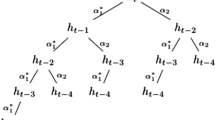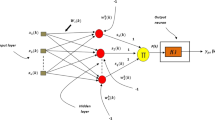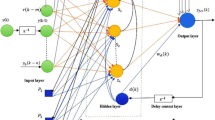Abstract
A fully connected continuous time recurrent neural network, trained by means of Real-Time Recurrent Learning, is investigated. A theoretical analysis of the output vector of the network during the training stage is performed. We point out the necessity to apply an additional constraint to the synaptic weight matrix with the intention of reducing the learning time while the forgetting is decreased. This constraint consists of updating the weights of the output cells using the output error gradient into the RTRL and a matrix of learning rates calculated from an average vector computed from the vectors previously memorized. For this first approach of the problem, only fixpoints attractors have been investigated. Some simple computational simulations validate the method.
Similar content being viewed by others
References
R.J. Williams and D. Zipser, “Experimental analysis of the recurrent learning algorithm”, Connection Science, 1, 87-111, 1989.
K. Doya and S. Yoshizawa, “Adaptive neural oscillator using continuous-time back-propagation learning”, Neural Networks, 2, 375-385, 1989.
K. Doya, “Bifurcations in the learning of recurrent neural networks”, Proceedings of the IEEE International Symposium on Circuits and Systems, 2777-2780, 1992.
D.J. Amit, Modeling Brain Function, The World of Attractor Dynamics, Cambridge University Press, 1989.
D. Parrachia, “Histoire et Philosophie du Concept de Réseau de Neurones”, in H. Paugam-Moisy, J.-P. Royet, D.A. Zighed (eds) Le Neuromimétisme: Epistémologie, Neurobiologie, Informatique, Hermes, 65-80, 1995.
J-F. Jodouin, Les réseaux neuromimétiques. Hermes, Paris, 1994.
M.L. Minsky and S.A. Papert, Perceptrons, MIT Press, Cambridge (MA), 1990.
R.J. Williams and D. Zipser, “A learning algorithm for continually running fully recurrent neural networks”, Neural Computation, 1(2), 270-280, 1989.
B. Pearlmutter, “Learning state space trajectories in recurrent neural networks”, Neural Computation, 1(2), 263-269, 1989.
R.A. Jacobs, “Increased learning rates through learning rate adaptation”, Neural Networks, 1, 295-397, 1988.
R. Glasius, A. Komoda and S.C.A.M. Gielen, “Neural network dynamics for path planning and obstacle avoidance”, Neural Networks, 8(1), 125-133, 1995.
A. Gottschalk, M.D. Ogilvie, D.W. Richter and A.I. Pack, “Computational aspects of the respiratory pattern generator”, Neural Computation, 6, 56-68, 1994.
Y. Hayashi, “Oscillatory neural network and learning of continuously transformed patterns”, Neural Networks, 7(2), 219-231, 1994.
G. Deco and B. Schürmann. “Neural learning of chaotic dynamics”, Neural Processing Letters, 2(2), 23-26, 1995.
Author information
Authors and Affiliations
Corresponding author
Rights and permissions
About this article
Cite this article
Druaux, F., Rogue, E. & Faure, A. Constrained RTRL To Reduce Learning Rate and Forgetting Phenomenon. Neural Processing Letters 7, 161–167 (1998). https://doi.org/10.1023/A:1009677128478
Issue Date:
DOI: https://doi.org/10.1023/A:1009677128478




